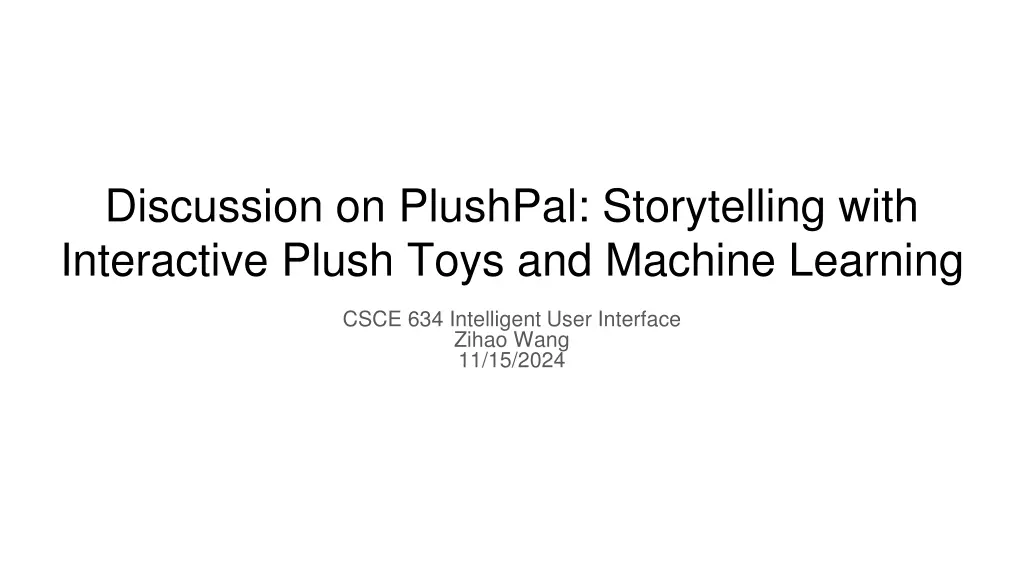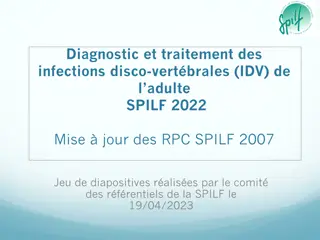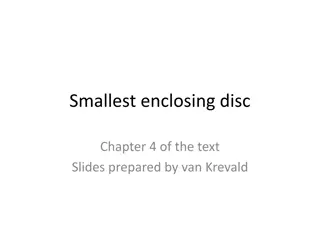
Interactive Plush Toys: Exploring Machine Learning Through Storytelling
"Discover PlushPal, a web-based tool for children to create interactive stuffed toys using machine learning. This innovative approach fosters creativity, teaches basic ML concepts, and engages kids in storytelling. Explore the relevance of AI education and Simon's theoretical perspective applied in toy design."
Download Presentation

Please find below an Image/Link to download the presentation.
The content on the website is provided AS IS for your information and personal use only. It may not be sold, licensed, or shared on other websites without obtaining consent from the author. If you encounter any issues during the download, it is possible that the publisher has removed the file from their server.
You are allowed to download the files provided on this website for personal or commercial use, subject to the condition that they are used lawfully. All files are the property of their respective owners.
The content on the website is provided AS IS for your information and personal use only. It may not be sold, licensed, or shared on other websites without obtaining consent from the author.
E N D
Presentation Transcript
Discussion on PlushPal: Storytelling with Interactive Plush Toys and Machine Learning CSCE 634 Intelligent User Interface Zihao Wang 11/15/2024
Introduction to PlushPal What is PlushPal? A web-based design tool for children aged 8-14 to make stuffed toys interactive. Uses machine learning (ML) for gesture recognition, allowing toys to respond to custom movements and sounds. Objective of PlushPal: To introduce children to basic ML concepts such as data sampling, model training, and evaluation. Fosters creativity through interactive storytelling, combining play and learning. Research Focus: Exploring how children engage with ML concepts. Examining their debugging practices and approach to creating custom ML models.
Relevance of Research Today Trends in AI Education: Increased focus on accessible ML tools to introduce AI literacy at younger ages. Aligns with current initiatives for computational thinking and data literacy in K-12 education. Examples of Related Tools: Google s Teachable Machine: Easy-to-use platform for creating ML models based on images, sounds, and poses without coding. MIT App Inventor: Empowers children to design mobile apps using basic ML concepts.
Relevance of Research Today Why it Matters: Data Literacy: Prepares children to understand and interact with AI in their daily lives. Creativity and Agency: Children gain hands-on experience designing technology, giving them control over how toys interact and respond. Long-term Impact: Equips young learners with foundational AI skills. Cultivates critical thinking about the role and limitations of AI.
Simons Theoretical Perspective Concept from Herbert Simon s Sciences of the Artificial Simon views artificial systems as tools that mimic real-world actions and intelligence. Emphasizes design as a process that extends human cognitive ability, allowing users to modify and control their environment. Connection to PlushPal: Mimicking Reality: PlushPal toys perform actions (like moving or making sounds) through gestures, mimicking real-world behavior. User Control and Customization: PlushPal empowers children to define gestures and sounds, creating personalized interactions with their toys. Feedback Loop and Iterative Design: Aligns with Simon s idea that design is a feedback-driven process where users experiment, refine, and adapt models based on interaction.
Simons Perspective Applied in PlushPal Design as a Cognitive Extension: PlushPal s interface encourages children to iterate and refine their models, enhancing their problem-solving and critical thinking skills. By customizing toy behavior, children learn how to manage and adapt technology to serve specific purposes. Interactive Feedback Loops: As children test gestures, they see real-time feedback, learning to adjust model parameters (e.g., more samples for accuracy). Reinforces Simon s belief in trial-and-error as a critical part of learning and design.
Suchmans Theoretical Perspective Concept from Lucy Suchman s Human-Machine Reconfigurations Emphasizes that human actions and machine responses are situational meaning emerges from specific contexts and interactions. Connection to PlushPal: Situated Actions: PlushPal lets children customize toys in unique ways, making each toy's interaction personalized and relevant to the child s own experience. Human-Machine Adaptation: Children s gestures and stories shape the ML model, allowing the toy s behavior to reflect individual personalities and contexts. Supporting Play as Contextual Interaction: Suchman s theory aligns with how PlushPal models user-specific behavior, creating individualized experiences and adapting machine responses to child-driven interactions.
Suchmans Perspective Applied in PlushPal Customized and Contextualized Interaction: Children s individual interactions drive the customization, as they connect gestures and sounds that reflect personal memories or imaginative stories. PlushPal as Situated Technology: ML models in PlushPal adapt based on how children teach their toys, turning the plush toy into a personalized companion with unique responses. Suchman s perspective highlights that toys are not one-size-fits-all; PlushPal enables dynamic, adaptable engagement based on each user s context.
Lessons for Our Project Our Project Objective: Building an AI-powered coding assistant, similar to Claude or GitHub Copilot, tailored for programming tasks. Key Takeaways from PlushPal: User-Centered Interaction: Just as children interact directly with their toys, our AI assistant can allow programmers to customize suggestions and refine the assistant s responses. Real-Time Feedback Integration: PlushPal s feedback-driven model allows children to adjust actions based on toy responses; similarly, our assistant could improve by incorporating user feedback on suggestions accuracy. Simplified Customization Interface: PlushPal uses an intuitive interface for gesture and sound linking. Our project can also benefit from a user-friendly interface where users specify coding preferences or style, making the AI more responsive to specific needs. Future Directions: Investigate ways to allow users to teach the AI assistant, similar to PlushPal s model training, for more accurate and contextually relevant coding assistance.

















